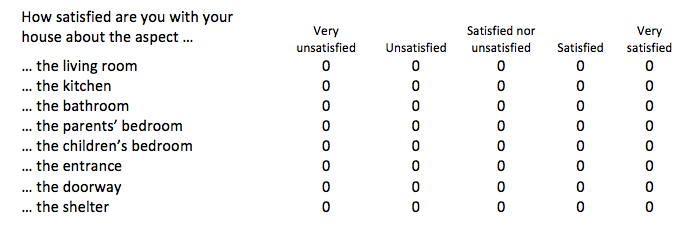
Likert scale
A Likert-scale is a question of which the answers are given on a scale with ordinary levels. Usually a five point scale is used but seven point scale is better.
A Likert scale has most of the time 5 answers, like very bad – bad – ordinary – good – very good or very satisfied – satisfied – normal – unsatisfied – very unsatisfied. Besides that, a lot of questions can be asked in a similar way so the layout looks nice. And there is another advantage: more questions can be answered in the same time. On average, a respondent can answer eight questions in one minute, but with a Likert scale, there are around twelve. A part of a questionnaire might look like this:

Combining the scores of questions on a Likert scale
All these questions can be analysed separately. The advantage of using Likert questions is that the answers can be combined to one score by assigning numbers to the answers and calculate the mean out of these scores.
For instance: very unsatisfied = 1, unsatisfied = 2, neither satisfied nor unsatisfied = 3, satisfied = 4 and very satisfied = 5. A higher score means more satisfied. This is usual score in many cultures: the higher the score, the better. However if you prefer the opposite (the lower the score, the better), then reverse the assignment of the scores. The way you code the scores is really arbitrary. I recommend assigning scores that are the easiest for you to interpret.
Though numbers are assigned to the answers, it is still not allowed to make calculations. We assigned numbers not values! In maths two and two may be four, but unsatisfied and unsatisfied isn’t suddenly satisfied. However a mean can be computed and can be very indicative. On a five point Likert scale in theory the middle is 3. So if the mean over all items is higher, this means the person is – in general – more satisfied.
It should always be checked if it is allowed to combine the answers of the Likert questions. A factor analysis and compute and evaluate Cronbach´s alfa. The factor analysis will tell if it is valid two combine the questions into one score, and Cronbach´s alfa will tell if the score is reliable. Read more about these aspects on the pages validity and reliability.
The advantage of computing a mean over the items on a Likert scale is that it creates an interval variable (on the condition that enough variation has been created). Now many more types of analysis can be carried out, like analysis of variance (ANOVA), correlation and regression (instead of the simple non-parametric tests). Besides that it reduces the numbers of freedom, so less respondents or objects are needed to satisfy the statistical conditions and it will make the statistical outcomes more stable.
Computing a mean or computing a sum?
In most textbooks the author advises to compute a sum score. This has a disadvantage. Suppose two lists of questions have been made on a 5-point Likert scale: eight questions are measuring motivation and twelve questions are measuring work pressure. Now the theoretical minimal score for motivation is 8 and the maximum is 40. For work pressure the minimum is 12 and the maximum is 60. Now scores aren’t easily compared. A score of 30 is rather high for the scale of motivation, but rather low on the scale of work pressure. If means were computed the score on motivation would be (30 / 8 =) 3.75 and the score for work pressure would be (30 / 12 =) 2.5.
Although the mean and the standard deviation are less, this does not affect the form of the distributions. If the sum score is used or the mean score, both will show the same statistical results in analysis of variance, correlation or regression.
The number of points of a Likert scale
A lot of discussion is going on about the number of points that should be used on a Likert scale. Nowadays usually scales with five points are used. People got used to it and the respondent rather easily interprets these five points.
A complaint of some scientists was that sometimes too many respondents chose the midpoint. These scientists wanted to force the respondent to speak out their favour for a positive or a negative opinion. Therefore a six-point Likert scale was used. As far as I can see, respondents took more time to answers these questions and sometimes even disliked these questions because they had neither a positive nor a negative attitude. It is my personal opinion that, if a positive or negative opinion is wanted, the scientist should make better questions or statements. Besides that, when a mean is computed over several questions, the score would reflect a positive or negative attitude and this doesn’t depend on a single question. Personally I do not recommend using a six point Likert scale, but if you like it, please don’t feel obstructed.
And how about a seven-points scale? This has a midpoint so it is not necessary for the respondent to force him to a positive neither a negative attitude. On a seven-point scale the respondent can give a more detailed answer to his attitude to the issue in the question. A finer detailed answer measures the things better. In order to make a scale, fewer questions are needed. Compared to the five-points scale a seven-points scale is less favourite because the respondent has to consider his answer. For this reason a nine-point scale or even an eleven-point scale is even less recommended.
A four-point scale or a three-point scale has not enough variation to make accurate measurements. Therefore these scales are not recommended too. Only when the scale is in one direction, a four-point scale might be useful, like in: never - sometimes - often - always. Now it is hard to find an extra point or bullet. Perhaps ‘almost always’ or ‘almost never’ are good extra alternatives.
All mentioned techniques are clearly explained in in our SPSS-tutorials.
Related topics to Likert scale
- Questions, types of -
- Variable
- Mean
- Standard deviation
- Skewness
- Kurtosis
- Factor analysis
- Reliability (Cronbach's alfa)




